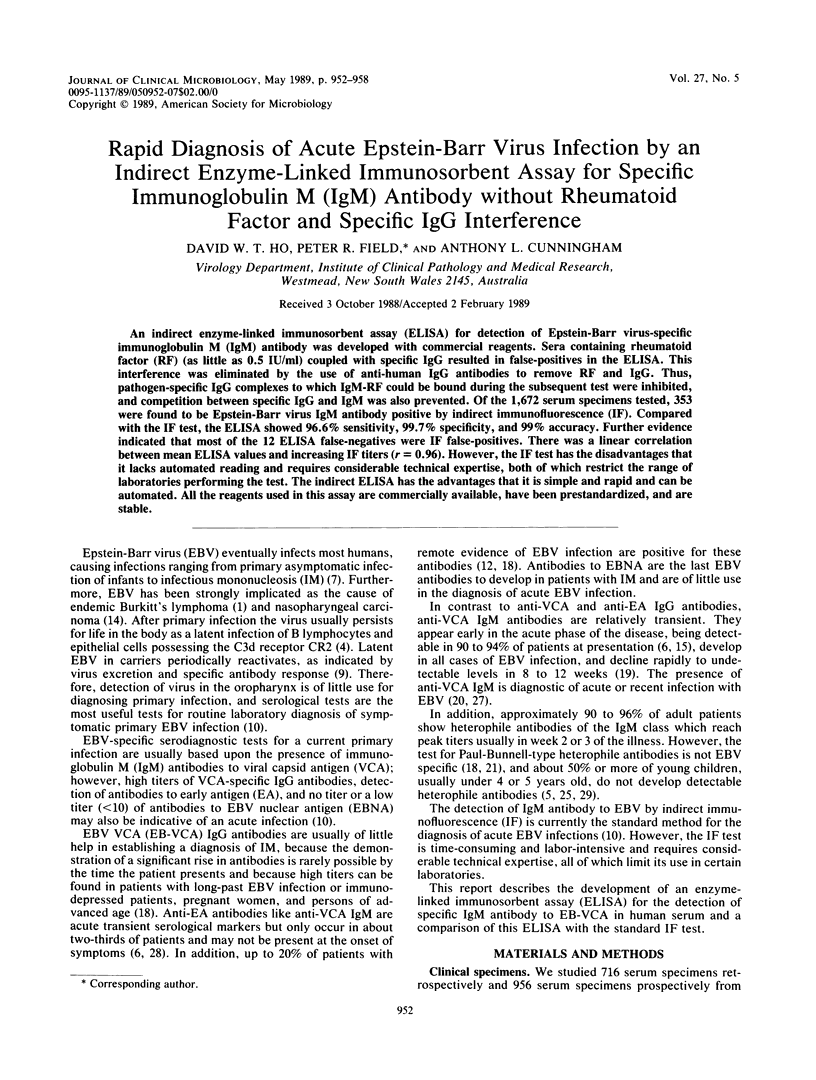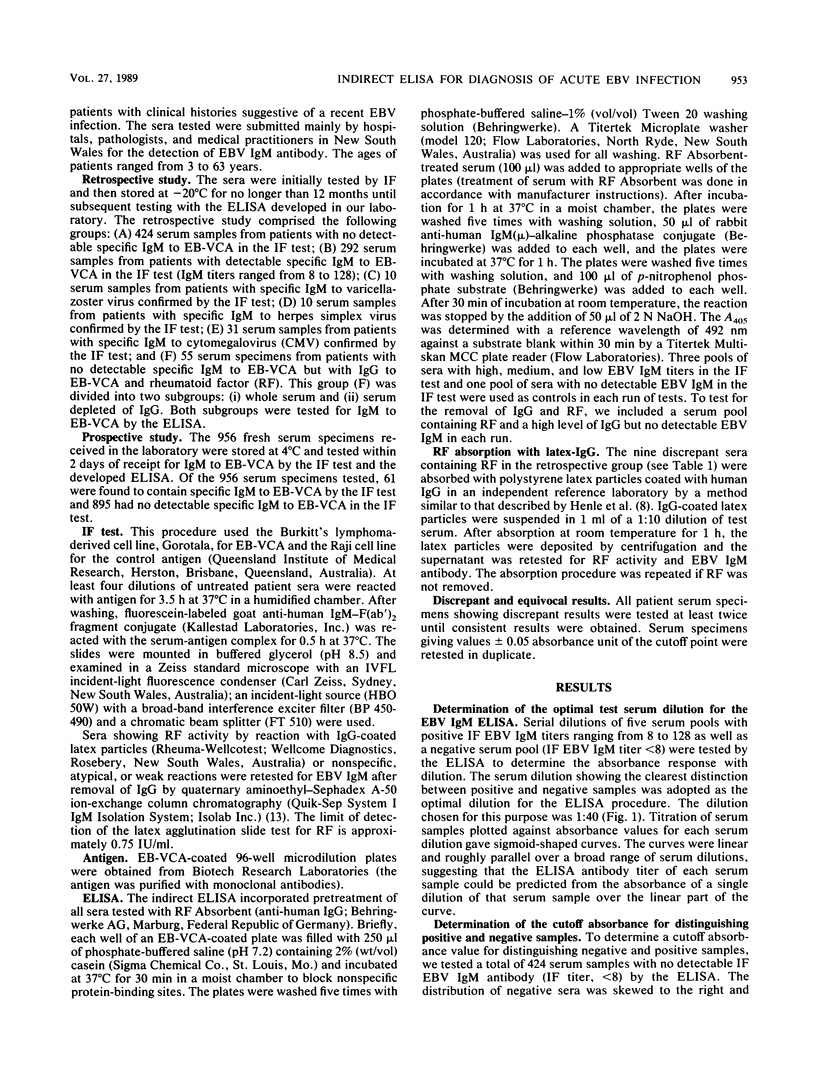Abstract
An indirect enzyme-linked immunosorbent assay (ELISA) for detection of Epstein-Barr virus-specific immunoglobulin M (IgM) antibody was developed with commercial reagents. Sera containing rheumatoid factor (RF) (as little as 0.5 IU/ml) coupled with specific IgG resulted in false-positives in the ELISA. This interference was eliminated by the use of anti-human IgG antibodies to remove RF and IgG. Thus, pathogen-specific IgG complexes to which IgM-RF could be bound during the subsequent test were inhibited, and competition between specific IgG and IgM was also prevented. Of the 1,672 serum specimens tested, 353 were found to be Epstein-Barr virus IgM antibody positive by indirect immunofluorescence (IF). Compared with the IF test, the ELISA showed 96.6% sensitivity, 99.7% specificity, and 99% accuracy. Further evidence indicated that most of the 12 ELISA false-negatives were IF false-positives. There was a linear correlation between mean ELISA values and increasing IF titers (r = 0.96). However, the IF test has the disadvantages that it lacks automated reading and requires considerable technical expertise, both of which restrict the range of laboratories performing the test. The indirect ELISA has the advantages that it is simple and rapid and can be automated. All the reagents used in this assay are commercially available, have been prestandardized, and are stable.
Full text
PDF






Selected References
These references are in PubMed. This may not be the complete list of references from this article.
- Evans A. S., Niederman J. C., Cenabre L. C., West B., Richards V. A. A prospective evaluation of heterophile and Epstein-Barr virus-specific IgM antibody tests in clinical and subclinical infectious mononucleosis: Specificity and sensitivity of the tests and persistence of antibody. J Infect Dis. 1975 Nov;132(5):546–554. doi: 10.1093/infdis/132.5.546. [DOI] [PubMed] [Google Scholar]
- Field P. R., Shanker S., Murphy A. M. The use of protein A-sepharose affinity chromatography for separation and detection of specific IgM antibody in acquired rubella infection: a comparison with absorption by staphylococci containing protein A and density gradient ultracentrifugation. J Immunol Methods. 1980;32(1):59–70. doi: 10.1016/0022-1759(80)90117-9. [DOI] [PubMed] [Google Scholar]
- Fingeroth J. D., Weis J. J., Tedder T. F., Strominger J. L., Biro P. A., Fearon D. T. Epstein-Barr virus receptor of human B lymphocytes is the C3d receptor CR2. Proc Natl Acad Sci U S A. 1984 Jul;81(14):4510–4514. doi: 10.1073/pnas.81.14.4510. [DOI] [PMC free article] [PubMed] [Google Scholar]
- Fleisher G. R., Collins M., Fager S. Limitations of available tests for diagnosis of infectious mononucleosis. J Clin Microbiol. 1983 Apr;17(4):619–624. doi: 10.1128/jcm.17.4.619-624.1983. [DOI] [PMC free article] [PubMed] [Google Scholar]
- Fleisher G., Lennette E. T., Henle G., Henle W. Incidence of heterophil antibody responses in children with infectious mononucleosis. J Pediatr. 1979 May;94(5):723–728. doi: 10.1016/s0022-3476(79)80138-9. [DOI] [PubMed] [Google Scholar]
- Henle G., Lennette E. T., Alspaugh M. A., Henle W. Rheumatoid factor as a cause of positive reactions in tests for Epstein-Barr virus-specific IgM antibodies. Clin Exp Immunol. 1979 Jun;36(3):415–422. [PMC free article] [PubMed] [Google Scholar]
- Henle W., Henle G. E., Horwitz C. A. Epstein-Barr virus specific diagnostic tests in infectious mononucleosis. Hum Pathol. 1974 Sep;5(5):551–565. doi: 10.1016/s0046-8177(74)80006-7. [DOI] [PubMed] [Google Scholar]
- Horwitz C. A., Henle W., Henle G., Polesky H., Balfour H. H., Jr, Siem R. A., Borken S., Ward P. C. Heterophil-negative infectious mononucleosis and mononucleosis-like illnesses. Laboratory confirmation of 43 cases. Am J Med. 1977 Dec;63(6):947–957. doi: 10.1016/0002-9343(77)90550-2. [DOI] [PubMed] [Google Scholar]
- Horwitz C. A., Henle W., Henle G., Rudnick H., Latts E. Long-term serological follow-up of patients for Epstein-Barr virus after recovery from infectious mononucleosis. J Infect Dis. 1985 Jun;151(6):1150–1153. doi: 10.1093/infdis/151.6.1150. [DOI] [PubMed] [Google Scholar]
- Johnson R. B., Jr, Libby R. Separation of immunoglobulin M (IgM) essentially free of IgG from serum for use in systems requiring assay of IgM-type antibodies without interference from rheumatoid factor. J Clin Microbiol. 1980 Sep;12(3):451–454. doi: 10.1128/jcm.12.3.451-454.1980. [DOI] [PMC free article] [PubMed] [Google Scholar]
- Lamy M. E., Favart A. M., Cornu C., Mendez M., Segas M., Burtonboy G. Study of Epstein Barr virus (EBV) antibodies: IgG and IgM anti-VCA, IgG anti-EA and Ig anti-EBNA obtained with an original microtiter technique: --serological criterions of primary and recurrent EBV infections and follow-up of infectious mononucleosis--seroepidemiology of EBV in Belgium based on 5178 sera from patients. Acta Clin Belg. 1982;37(5):281–298. doi: 10.1080/22953337.1982.11718879. [DOI] [PubMed] [Google Scholar]
- Linde A., Andersson J., Lundgren G., Wahren B. Subclass reactivity to Epstein-Barr virus capsid antigen in primary and reactivated EBV infections. J Med Virol. 1987 Feb;21(2):109–121. doi: 10.1002/jmv.1890210203. [DOI] [PubMed] [Google Scholar]
- Luka J., Chase R. C., Pearson G. R. A sensitive enzyme-linked immunosorbent assay (ELISA) against the major EBV-associated antigens. I. Correlation between ELISA and immunofluorescence titers using purified antigens. J Immunol Methods. 1984 Feb 24;67(1):145–156. doi: 10.1016/0022-1759(84)90093-0. [DOI] [PubMed] [Google Scholar]
- Merlin T. L. Chronic mononucleosis: pitfalls in the laboratory diagnosis. Hum Pathol. 1986 Jan;17(1):2–8. doi: 10.1016/s0046-8177(86)80149-6. [DOI] [PubMed] [Google Scholar]
- Nikoskelainen J., Hänninen P. Antibody response to Epstein-Barr virus in infectious mononucleosis. Infect Immun. 1975 Jan;11(1):42–51. doi: 10.1128/iai.11.1.42-51.1975. [DOI] [PMC free article] [PubMed] [Google Scholar]
- Pochedly C. Laboratory testing for infectious mononucleosis. Cautions to observe in interpreting results. Postgrad Med. 1987 Jan;81(1):335-9, 342. doi: 10.1080/00325481.1987.11699687. [DOI] [PubMed] [Google Scholar]
- Rapp C. E., Hewetson J. F. Infectious mononucleosis and the Epstein-Barr virus. Am J Dis Child. 1978 Jan;132(1):78–86. doi: 10.1001/archpedi.1978.02120260080020. [DOI] [PubMed] [Google Scholar]
- Robertson P. W., Whybin L. R., Cox J. Reduction in non-specific binding in enzyme immunoassays using casein hydrolysate in serum diluents. J Immunol Methods. 1985 Jan 21;76(1):195–197. doi: 10.1016/0022-1759(85)90491-0. [DOI] [PubMed] [Google Scholar]
- Schmitz H. Detection of immunoglobulin M antibody to Epstein-Barr virus by use of an enzyme-labeled antigen. J Clin Microbiol. 1982 Aug;16(2):361–366. doi: 10.1128/jcm.16.2.361-366.1982. [DOI] [PMC free article] [PubMed] [Google Scholar]
- Schmitz H. Improved detection of virus-specific IgM antibodies. Elimination of non-specific IgM binding. J Gen Virol. 1978 Aug;40(2):459–463. doi: 10.1099/0022-1317-40-2-459. [DOI] [PubMed] [Google Scholar]
- Schmitz H., Volz D., Krainick-Riechert C., Scherer M. Acute Epstein-Barr virus infections in children. Med Microbiol Immunol. 1972;158(1):58–63. doi: 10.1007/BF02122009. [DOI] [PubMed] [Google Scholar]
- Schmitz H., von Deimling U., Flehmig B. Detection of IgM antibodies to cytomegalovirus (CMV) using an enzyme-labelled antigen (ELA). J Gen Virol. 1980 Sep;50(1):59–68. doi: 10.1099/0022-1317-50-1-59. [DOI] [PubMed] [Google Scholar]
- Sumaya C. V., Ench Y. Epstein-Barr virus infectious mononucleosis in children. II. Heterophil antibody and viral-specific responses. Pediatrics. 1985 Jun;75(6):1011–1019. [PubMed] [Google Scholar]
- Sumaya C. V., Ench Y., Pope R. M. Improved test for IgM antibody to Epstein-Barr virus using an absorption step with Staphylococcus aureus. J Infect Dis. 1982 Oct;146(4):518–523. doi: 10.1093/infdis/146.4.518. [DOI] [PubMed] [Google Scholar]
- Sumaya C. V. Endogenous reactivation of Epstein-Barr virus infections. J Infect Dis. 1977 Mar;135(3):374–379. doi: 10.1093/infdis/135.3.374. [DOI] [PubMed] [Google Scholar]
- Vogt R. F., Jr, Phillips D. L., Henderson L. O., Whitfield W., Spierto F. W. Quantitative differences among various proteins as blocking agents for ELISA microtiter plates. J Immunol Methods. 1987 Jul 16;101(1):43–50. doi: 10.1016/0022-1759(87)90214-6. [DOI] [PubMed] [Google Scholar]


